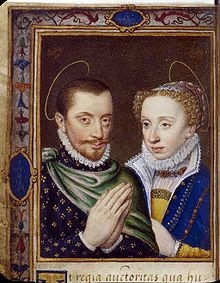Carlos III (18 de febrero de 1543 - 14 de mayo de 1608), conocido como el Grande , fue duque de Lorena desde 1545 hasta su muerte.
Fue el hijo mayor sobreviviente de Francisco I, duque de Lorena , y Cristina de Dinamarca . [1]
En 1545, su padre murió y su madre ejerció de regente durante su minoría de edad. Durante su infancia, su anciana bisabuela, Felipa de Güeldres , murió en 1547, dejando también su herencia al joven Carlos. Su dinastía reivindicó el Reino de Jerusalén y utilizó también el título de Duque de Calabria como símbolo de sus pretensiones al Reino de Nápoles . Además, tenían pretensiones sobre el Ducado de Güeldres , heredado de Carlos de Egmont, Duque de Güeldres .
En 1552, Lorena fue invadida por Francia, la regencia de su madre terminó y Carlos fue trasladado de Lorena a Francia, para ser criado en la corte real francesa de acuerdo con las necesidades de los intereses franceses. [2] Según Julio Alvarotto, enviado de Ercole II d'Este, duque de Ferrara , Carlos pagó una mascarada que involucraba barcos de desfile con velas de tela plateada, diseñada por Bartolomeo Campi , en la boda de María, reina de Escocia, y Francisco, delfín de Francia , el 24 de abril de 1558. [3] Durante el desfile bailó con su futura esposa, Claude de Francia . [4] En 1559, se casaron y se le permitió partir a Lorena y tomar el control de su dominio.
El reinado de Carlos III se considera una gran época de paz y prosperidad para Lorena. Siguió una política de neutralidad entre Francia y el Sacro Imperio Romano Germánico, así como durante las Guerras de religión francesas. Fundó la Universidad de Pount-a-Mousson . También expandió su reino con la incorporación de Pfalzburg de Jorge Juan I, conde palatino de Veldenz , en 1590, e intentó conquistar también Lützelstein, aunque la viuda de Jorge Juan I, Ana de Suecia , logró negociar una tregua.
En 1589, rompió su política de neutralidad y se alió con la Liga Católica Francesa porque, como católico, no podía aceptar a Enrique de Navarra como rey de Francia. En su paz con Enrique en 1594, casó a su hijo con la hermana de Enrique, Catalina de Borbón .
Se casó con Claudia de Valois , princesa de Francia , hija del rey Enrique II y Catalina de Médici . [5] Tuvieron los siguientes hijos:
